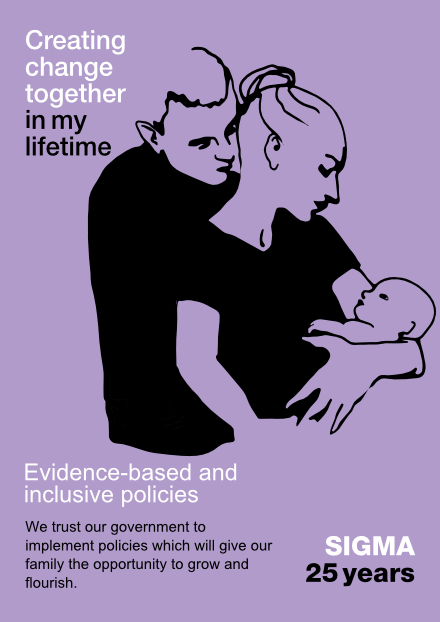SIGMA › Events › SIGMA 25 Years Characters
SIGMA 25 Years Characters

 |
Service DeliveryService delivery represents good governance at a tangible level: citizens and businesses view the public sector as a provider of services, which they pay for through their taxes. Public administration must therefore be citizen and business orientated. Services need to be first and foremost accessible to all; they also need to be efficient and effective as well as assured in a continuous and consistent manner.Depending on the country, the public sector provides a wide array of services to citizens throughout their lives. The public increasingly compares public sector services to those provided by the private sector, and expects these services to be of equal quality. Changing demographics and budgetary constraints means that service delivery has to stay up to date in a rapidly changing world to meet these expectations and still remain affordable.A government must provide its citizens with certain services, this is a legal provision of most constitutions, but beyond that the services provided need to be of high quality and succeed in saving citizens and businesses time and money. |
 |
Accountability
An accountable government explains the reasons for its activities, accepts responsibility for them and reports on results in a transparent manner. It uses websites to proactively disclose information and if citizens or businesses want to know more, they may access the relevant information easily and at no cost. Any exemptions to this transparency should be rare and based in law; a designated authority oversees whether information is provided when requested.An effective and efficient public administration is organised in a rational way. Ministries and agencies need well-defined roles, easily understandable by all, with simple lines of responsibility in place within and between institutions. In addition, clear objectives and reporting obligations help managers focus on results.To ensure an effective system of checks and balances, independent institutions actively help citizens and businesses to exercise their right to hold the administration accountable: the Ombudsman protects their human rights, the Supreme Audit Institution makes sure their taxes are spent wisely, while administrative judges ensure that they are treated fairly in administrative disputes.Finally, if public authorities act unlawfully or in cases of wrongdoing, citizens or businesses who have suffered damages are able to seek a fair solution or ultimately can go to court and obtain compensation.
|
 |
Public service and human resource management
Public servants are the people who deliver the government’s priorities and public services to the citizens and businesses in their country. To provide good and continuous services, the main objective of every public servant should be professionalism.In order to have professional public servants, and high standards of human resource management to support them, several measures need to be taken to ensure their independence. Merit-based recruitment, equal treatment of civil servants, and fair and transparent remuneration are equally important. Professional development and training should be arranged to ensure a high level of competency of public servants and to support their ongoing skills development. Every public servant also needs to be held accountable for what they are responsible, with clearly defined rights and obligations.The public service shapes the face of government as citizens have direct and frequent contact with them. As a significant employer, a government has both the obligation and the opportunity to lead by example, setting high standards for society as a whole. Building a truly professional and efficient public service is the best way for a government to demonstrate respect for its citizens and businesses.
|
|
|
Policy development and co-ordinationPolicies are the translation of ideas into efficient strategies to enable a government to achieve its objectives. They create value for societies at large by building better environments in which the quality of life is improved and doing business becomes easier. Such policies are most effectively developed and implemented when there is a well-organised, co-ordinated, consistent and competent policy-making system. The roles of the different institutions should be clearly defined so as to avoid overlapping or fragmentation.Policymaking must be inclusive and rely on evidence so that the creation of a new policy achieves the intended objective. Using relevant data, analysing likely impacts and engaging those affected is the best way to ensure that policy decisions are relevant and applicable, as well as understandable for citizens and businesses.While creating new policies or changing the existing ones, decision makers should take into account that legislation needs to be predictable and consistent. To reach fruition, policies require effective communication and public consultation, and implementation plans which respect the budget available and financial sustainability.If these steps are followed, policy development and co-ordination will generate transparent, efficient and clear policies which will improve people’s lives. |
 |
Public financial managementPublic financial management is a central component of public administration reform. An active strategic framework of reforms needs projections based on realistic finances in order to attain the desired economic and social policy objectives to benefit citizens and businesses.Sound management of public finances is essential as the government sets the trends for public and private investments. Cash and debt management, and the reporting of financial data, must be monitored, transparent and based on reliable information, including public procurement, where practices need to be particularly clear and honest to avoid corruption.Robust public financial management systems need to be implemented in all the elements of the budget cycle, including internal and external audits. A well-functioning internal audit is independent and objective. It provides assurance and advice, which adds value and improves an organisation’s operation. Furthermore, to strengthen the accountability of a government and public sector entities in general, scrutiny from an independent and professional Supreme Audit Institution (SAI) is essential.Once implemented and visible, these high standards of public financial management create a greater level of trust amongst citizens towards their governments. |
 |
Strategic framework of public administration reformIn PAR, a strategic framework embodies the vision a government has for the development of an effective public administration in their country. PAR is a critical horizontal reform area because it provides the foundation for all other policies to be built on.Strategic planning is needed to create an ambitious but achievable roadmap for implementing policies in every sector of government. These policies should translate ideas and priorities into clear objectives. Institutions should be tasked with realising them, the necessary resources allocated for successful implementation and performance indicators established to measure achievements.An effective strategic framework will allow a government to prioritise within and between different sectors, to make difficult choices in order to forge a citizen-focused administration and a balanced budget for their countries, for years to come.Citizens want to see a brighter future become a reality. For this to happen, governments need to have clear direction and leadership. Goals must be set and systems transformed so that citizens and businesses can see benefits today, as well as longer-term results. |
|
|
|
Credit to the TEN network and WeBER project |
Related Documents
.jpg)
